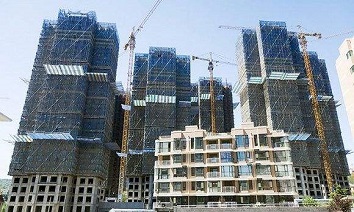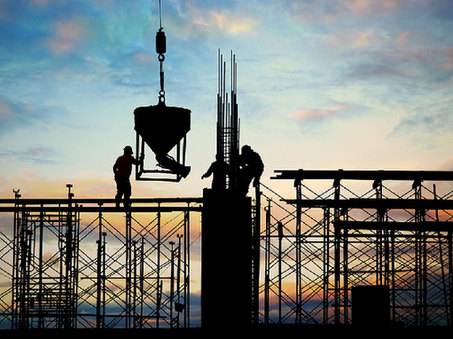
(Editor: Leona) Fallout from the property industry is taking a toll on many sectors of the economy, reports Bloomberg.
A long-running residential building boom is petering out, with the effects seen from slumping steel and cement prices, to electricity use, rail traffic and retail sales.
The drag will be long-lasting with home completions set to fall by 1 to 3 percent annually from next year to 2025 after almost tripling in 13 years, according to Beijing-based research company Gavekal Dragonomics. A once-in-a-generation shift in demand for housing and an overhang of supply suggest that the government can only cushion the effect with interest rate cuts such as the one announced Nov 21, not reverse it.
"The turning point has come," said Wang Tao, chief China economist at UBS Group AG in Hong Kong, China. "Construction has to come down so that means growth has to slow, and therefore steel demand, cement demand, energy consumption, mining production, appliances, automobiles-everything has to come down."
The challenge for Premier Li Keqiang is that services and consumption are not picking up the slack quickly enough, leaving China set for its weakest full-year expansion since 1990. Increasing evidence the slowdown is structural, not cyclical, is playing out on commodity markets and leaves the United States shouldering prospects for a pickup in 2015 global growth.
Bloomberg's monthly GDP tracker shows China's growth slowed to 6.91 percent in October from a year earlier, the third straight month below 7 percent and the weakest stretch since the start of 2009.
Most of the tracker's seven gauges-industrial production, electricity production, passenger traffic, railway freight volume, investment, retail sales and exports-are either slowing or falling.
Housing's influence on the economy is pervasive, driving down sales of everything from cement to steel, electrical appliances, furniture and cars. Its contribution to China's growth and thereby to global expansion makes it "the most important sector in the universe", Jonathan Anderson, former chief economist for emerging markets at UBS who now runs Beijing-based Emerging Advisors Group, wrote in a 2011 research note.
Real estate and construction accounted directly for 15 percent of 2012 GDP, one-quarter of fixed-asset investment, 14 percent of urban employment and about 20 percent of bank loans, the International Monetary Fund said in a July report. About 39 percent of government revenue was related to the property industry last year, Nomura Holdings Inc said.
Signs of the reversal in property are evident from a 10 percent slump in home sales in the first 10 months of 2014, triggered by waning investor demand and less need for upgrading to larger dwellings, both pillars of the decade-long boom.
Prospects for a recovery are damped by a supply overhang after the building binge that accelerated when the government spurred a record borrowing spree in response to the global financial crisis.
The fallout is rippling across the economy. Industrial output in October expanded 7.7 percent from a year earlier, the second-weakest pace since 2009, while retail sales gained the least in eight years. Investment in fixed assets grew 15.9 percent in the January-October period, down from a 20.1 percent pace in the same period in 2013.
Electricity output growth slowed to an average of 4 percent in January through October, less than half the pace of the previous five years. Freight traffic volume on the nation's rail network slumped 7.5 percent in October from a year earlier, the 10th straight decline, the longest losing streak since the 2008-09 global slowdown. Fewer coal shipments accounted for much of the drop.
"There has been a slowdown in industry and industries have been a big consumer of coal," said Wei Jiangping, a market manager at coal producer Inner Mongolia Yuan Xing Energy Co. "It's all related. The property industry slows, and that leads to a slowing of demand from the cement and glass industries."
Rosealea Yao, an analyst at Gavekal Dragonomics in Beijing, said real estate and construction's contribution to GDP will probably slide to 28 or 29 percent by the end of the decade from about 33 percent this year and more than 34 percent in 2011.
It will take as many as six years for excess land supply to be digested in third-and fourth-tier cities, four years in second-tier and two years in first-tier cities, Nomura said.
Even a leveling off of property investment will drag on growth and construction-related commodities including steel, copper and cement, said Patrick Chovanec, chief strategist at Silvercrest Asset Management Group LLC in New York.
"You don't have to have a big crash to have a big impact on the growth rate," said Chovanec, a former associate professor at Beijing-based Tsinghua University. "If you just build the same number of condos and villas and apartments that you did last year but no more, then it's not a contributor to GDP growth."
Industries making up China's "new" economy, including private enterprise output, vehicle exports, clean energy production, communication equipment and computer output, are faring better, though not accelerating quickly enough to prevent the economy's slowdown.
Bloomberg's China Real Activity Index for such new drivers expanded 11.9 percent in October from a year earlier, while a gauge of the "old" forces including real estate investment, ferrous-metal ore production and output of State-owned enterprises expanded 5.3 percent, the slowest since May 2009.
While retail sales data point to a slowdown, e-commerce is booming, with online sales rising 18 percent in the third quarter, according to Shanghai-based iResearch Consulting Group. Online shopping surged 50 percent from a year earlier, led by Alibaba Group Holding Ltd's Tmall with a 58 percent share, while travel sales jumped 20 percent.
Because service industries, which replaced manufacturing and construction as the biggest part of the economy last year, require about 30 percent more jobs per unit of GDP than industry, the nation's economic growth rate can slow while still providing ample employment, said Stephen Roach, former chief economist at Morgan Stanley.
"Most people around the world are very negative on China because they see GDP growth slowing," said Roach, a senior fellow at Yale University's Jackson Institute of Global Affairs and author of Unbalanced, which explores the links between China and the US.
"China is shifting its economic growth into more labor-intensive services industries and that's a big deal. It doesn't matter if GDP growth is slowing so long as employment growth is increasing, and it is."
Roach said slower GDP growth accompanied by services-creating structural changes will be good for China.



























 沪公网安备31010402003309号
沪公网安备31010402003309号